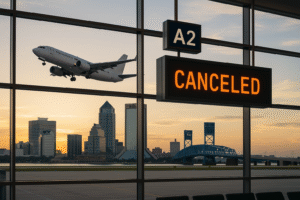Travel plans can feel like sandcastles: sturdy one moment, washed away the next. If you’ve heard rumors about airlines cutting routes ON Jacksonville International Airport (JAX), you’re not alone. In this deep dive, we’ll trace the history of air service at JAX, dissect recent flight discontinuations, and help you navigate the shifting skies with practical tips.
A Brief History of Air Service at JAX
Early Years and Growth
When aviation took off in the 1920s, Jacksonville was eager to hop aboard. Small prop-driven mail planes paved the way for passenger flights. By mid-century, JAX had established itself as a regional hub, connecting the First Coast to major metropolises.
The Jet Age and Expansion
The 1960s ushered in jets, shrinking travel times dramatically. Airlines like Eastern and Delta added nonstop service to New York, Chicago, and Atlanta. Growth continued through the 1980s, with carriers experimenting with leisure routes to Florida’s theme parks.
Recent Route Cuts: The Headlines
Major Airlines Pulling Out
Lately, big names such as Airline A and Airline B announced they’d suspend service from JAX. These decisions stunned passengers who relied on direct flights to business centers or vacation spots.
Key Discontinued Destinations
Some of the most talked‑about cuts include nonstop service to City Y and seasonal flights to Resort Z. If you flew those routes regularly, you’ve likely noticed schedule gaps on the booking engines.
Why Airlines Discontinue Flights
Economic Pressures and Fuel Costs
Jet fuel isn’t cheap. When crude prices spike, airlines trim unprofitable routes first. It’s like pruning a tree: sacrifice a few branches to keep the rest healthy.
Shifting Demand Patterns
Business-travel habits have changed. Video conferencing can replace a one‑hour flight. Leisure travelers may favor all‑inclusive package deals, diminishing demand for certain single-city routes.
Airline Network Strategies
Carriers constantly reconfigure their route maps. A decision to focus on hub‑and‑spoke models can mean shedding smaller markets. Jacksonville might be a “spoke” in that network, making it vulnerable if load factors dip.
The Local Impact of Flight Discontinuations
Business Travelers and Tourism
For professionals flying ON tight schedules, a lost nonstop can add hours or an extra connection. Tourism dollars flow not just to hotels, but restaurants and attractions—each canceled route can feel like a trickle turned to a drip.
Cargo and Logistics Effects
Passenger flights often carry high‑priority cargo. A discontinued flight can slow supply chains, affecting local manufacturers and retailers.
Community Sentiment
Residents tie pride to their airports. Losing a flight can feel like losing a piece of identity. Local chambers of commerce often lobby airlines to restore service, highlighting potential demand.
Alternatives for Affected Travelers
Connecting Through Nearby Hubs
Instead of seeking a direct flight, consider routing through hubs such as Atlanta (ATL) or Charlotte (CLT). Sure, it adds layover time, but savvy travelers can minimize delays by choosing tight connection windows.
Ground Transportation Options
Road trips aren’t dead yet. For destinations within 300 miles, driving or taking a regional bus can be more predictable—and sometimes even faster when you factor in security lines.
Low-Cost Carrier Solutions
Budget airlines may fill gaps left by majors. Keep an eye on promotional sales for one‑way tickets; sometimes bidding wars between carriers bring prices down.
Case Study: Discontinuation of Airline X’s Service to City Y
Background of the Route
Airline X launched its JAX–City Y service in 2018, banking on corporate demand. The two-hour flight promised morning arrivals and evening returns.
Passenger Numbers and Load Factors
Despite initial optimism, average seats filled hovered around 60%. Industry analysts peg 70–75% as the break-even point for profitability on regional routes.
Lessons Learned
It’s a reminder that not all shiny new routes endure. Market research must account for seasonal swings, fare sensitivity, and business-travel elasticity.
Economic Analysis of Route Withdrawals
Revenue Loss vs. Cost Savings
Airlines weigh potential ticket revenue against crew costs, airport fees, and fuel. Cutting a marginal route might save millions annually, even if it disappoints regular fliers.
Ripple Effects on Local Economy
Studies show that airports generate jobs beyond their fences—hotels, logistics firms, and catering services rely on consistent flight activity. Each canceled flight can cost dozens of local jobs indirectly.
How JAX Is Responding
Incentives for New Routes
The airport authority may offer reduced landing fees or marketing support to entice carriers back. It’s akin to a city giving tax breaks to attract businesses.
Marketing and Community Outreach
“Fly Local” campaigns urge residents to book ON JAX instead of driving to competing airports. A collective push can boost load factors and justify route reinstatement.
Infrastructure Improvements
JAX has modern terminals and runway upgrades in the pipeline. Demonstrating readiness for more traffic can sweeten the deal for airlines scouting expansion.
Predicting Future Trends
Potential New Destinations
Experts eye underserved markets like Austin (AUS) and Nashville (BNA) as next targets. If the local economy grows, these nonstop links could make sense.
Role of Regional Partners
Partnering with regional carriers or codeshare agreements can maintain connectivity even if majors step back.
Impact of Emerging Technologies
Electric and hybrid aircraft promise lower operating costs. In a decade, we might see niche routes revived on quieter, greener planes.
Tips for Staying Informed
Signing Up for Alerts
Airlines and JAX both offer email notifications for schedule changes. Subscribing ensures you’re the first to know about route suspensions or resumptions.
Using Flight Monitoring Tools
Apps like FlightAware or Routehappy track aircraft in real‑time. If you notice a plane pulled from rotation, you’ll spot a pattern before carriers announce it publicly.
Conclusion
Airline route decisions are a complex dance of economics, demand, and strategy. While Jacksonville has weathered cuts before, the community’s response—through advocacy, local booking, and creative partnerships—can influence which flights take off next. By staying informed and exploring alternatives, travelers can adapt when nonstops vanish and reserve hope for fresh connections on the horizon.
FAQs
1. Why do airlines discontinue flights from Jacksonville?
Airlines cut routes primarily due to low passenger loads, high operating costs (like jet fuel), and strategic network shifts that favor larger hubs over smaller markets.
2. How can I find out if my preferred route is at risk?
Sign up for email alerts from both the airline and JAX, and monitor flight‑tracking apps to spot declining aircraft rotations leading up to a route suspension.
3. What are the best alternatives if a nonstop flight is canceled?
Consider connecting through major hubs such as Atlanta (ATL) or Charlotte (CLT), explore driving or bus options for shorter trips, or look for budget carriers serving nearby airports.
4. Can community efforts really bring back discontinued routes?
Yes—airport authorities and chambers of commerce often negotiate incentives with airlines. A surge in local bookings on remaining flights can demonstrate demand and prompt reinstatement.
5. Will emerging technologies change the landscape of regional air service?
Absolutely. Electric and hybrid aircraft promise lower operating costs and quieter operations, making low‑demand routes economically viable again in the coming decade.


